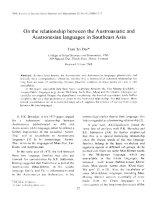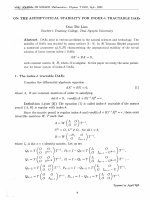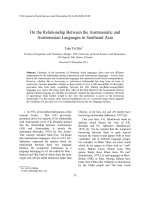DSpace at VNU: On the relationship between the Aưstroasiatic and Austronesian languages in Southeast Asia
Bạn đang xem bản rút gọn của tài liệu. Xem và tải ngay bản đầy đủ của tài liệu tại đây (989.21 KB, 6 trang )
VNU Jo u m al of Science, Sorial Sciences a n d H u m an itíes 25, N o.5E (2009) 12-17
On the relationship between the Aưstroasiatic and
Austronesian languages in Southeast Asia
Tran Tri Doi*
C o llc g e o f S o c i a l S c ie n c e s a n d /lu m a n iỉie s , V N U
336 Nguyên Trai, Thanh Xutin. ìỉanoi, Vieínam
R e c e iv e d 2 0 Ju n e 2 0 0 9
A b s t r a c t . A s h a v c b c c n k n o w n , th e A u s iro a s ia tic a n d A u s tro n c s ia n la n g u a g c s p h o n e tic a lly an d
le x ic a lly h a v c c o rrc s p o n d c n c c . H o w c v c r, w h c th c r th is
1S
h o rro w e d o r iíĩh e n te d re la tio n s h ip h a s
lo n g b c c n a n is s u e o f c o n tro v c rs y , b c c a u se p la u s ib ỉe e v id c n c c to th c s c p o in ls o f v ie w 1S still
u n a v a ila b le .
In th is p a p c r, c q u iv a le n t d a ta íro m b a s ic v o c a b u la ry b c tw c c n th c V ic t M u o n g d is y lla b lic /
s c s q u is y lla b lic la n g u a g c s (c .g . A re m , M a L ie n g , S a c h . R u c , A h e u ) a n d th e C h a m ic la n g u a g c s arc
c a rc íu lly in v e s tig a tc d . D c s p itc th e sh a re d b a s ic v o c a b u la ry , th is k in d o f c q u iv a le n c e le n d s lu rth e r
w e ig h t to th c v ic w th a t p r e fe re n c e is g iv e n to th e b o rro w e d r c la tio n s h ip . F o r th a t rc a so n , Ih ese
le x ic a l rc s c m b la n c e s a rc o f a re s tric te d r a n g e vvhieh s u p p o rts th c re la tio n o f sp e c ia ỉ b o rro w in g s
b e tw c e n th e tw o la n g u a g e s.
1.
P.K. Benedict, in his 1973 papcr, argued
for a ‘substratum ’ rclationship betw een
A ustronesian (abbrcbrialcd as AN) and
A ustroasialic (A A ) languagcs w hcn hc otTered a
furlhcr cxplanation o f ihc so-called ‘AustroT h a i’ and Its rclatcdncss to Ausiroasiatic
languages [1]. In his term inology, ‘AustroT h a i’ refers to thc languages o f M iao-Yao, TaiKadai, and A ustronesian.
In thc samc ycar o f 1973, ihc link bctvvcen
thesc t\vo languagc íam ilies w as also put
forward for consideration hy S.E. Jakhontov.
H aving suggcstcd that Vieừiam cse is part o f the
A ustroasiatic (M on-K hm er, in his vvords)
language family and Tai is inhcritancc-rcíated
to thc A ustronesian (or Indoncsian, in his
• DT: 84-4- 35588603.
E-mail: d o ih a n h ậ yahoo.com
12
ternnnology) ralh cr than to Sino languagcs, this
link is rcgardcd as a borroxving rclationship [2].
A year latcr, A.Cì.ỉIaudicourt shared thc
sam c linc o f analysis w ith P.K. Benedict and
S.E . Jakhontov (3,4]. IIc furlhcr cmphasizcd
that tlìis is a spccial borrovving rclationship
sincc thc sharcd w ords o f the two language
fam ilics belong to the basic vocabulary and
regularly appcar in diíTcrent sub-groups. As hc
pointcd out, thcrc arc som e M on-Khmcr worđs
in the M alaysian language, vvhich are
unavailable in the Cham languages, for
instance: ‘c ra b ’ ketam, Bahnar kotam, Khmer
ktam , M on ỊỊUlam, Sam re tham, Khasi tham,
W a ta m " (3, tr.3 3 ]. Also, the vocabulary o f
som e M on-K hm cr languagcs mcluding Maa,
M nong, B ahnar consists essentially o f Ioans
m ade ỈVom thc C ham languagcs as a
consequcncc o f thc long-tcrm dom inance o f the
T.T. Doi / V N U ịournaì o f Science, Soãal Sciences and Humanities 25, No.5E (2(X)9) 12-17
Cham people. Notcvvorthily, ‘thc borrowcd
lexicon onginatcd either from Sanskrit
or
Indoncsian languagcs’ [3, tr.33].
T he issue seem s to be sorted out until lately
som e othcr proposals o f thc classiíìcation o f
Southcast A sian languagcs have bcen released.
M ost recently, from sound corrcspondences,
shared vocabulary and sharcd m orphology, L.
Sagart (2004) has argucd ihat the T ai-K ađai
languages are a subgroup o f A ustroncsian and
additionally, A ustroncsian and C hinese are
genetically relatcd w ithin a m acrophylum
w hich
he
callcd
‘Proto-Sino-T ibctanA ustronesian' (PSTA N ) [5]. A ccordingly, in
the area o f prc-litcrate Southcast A sia and
South China, Sino-Tibetan, A ustronesian, and
Tai-Kadai languages all bclonged lo a macrofamily, vvhich excluding A ustroasiatic.
Thcrcíore, despite o f diffcrcnt approaches,
previous scholars have shared th e sam e idea
Ihat the correspondence betw een A ustroasiatic
(particularly M on-K hm er) and A ustroncsian
languagcs is not as p ro o f o f an inheritance
relationship, but as a result o f borrow ings.
2.
On the othcr hand, Phạm D ức D ương, in
his effort to build up a m odcl o f a m ixed
languagc vvhich ariscs through language
contact, has been argucd for a hypothesis o f
‘ngừ hệ D ông Nam Á ’ (literally means:
Southeast A sian language-fam ily) o r ProtoA ustroasiatic as he íurthcr explained. In his
system, this languagc fam ily consists o f the
languages o f A ustroasiatic, A ustroncsian and
Dong Tai (cquivalcnt to T ai-K adai in other
systems) [6, tr.30]. It m cans that A ustroasiatic
and A ustronesian initially originated from the
same fam ily, w hich subscqucntly divided into
three
present-day
sub-groups,
nam ely
A ustroasiatic, A ustroncsian and D ong Tai.
Phạm Đ ức Dương, hovvcvcr, provided only
ethnolinguistic argum cnts to support his*
position. Strictly spcaking, linguistic evidence
for a kin relationship bctw ccn A ustroasiatic and
13
A ustronesian has yct to be prcsented. A lthough
m any aspccts o f this hypothcsis rem ain unclear,
there is solid indication that thc special
relatedness bctvvccn the tvvo language íam ilies,
w hich vvas first noticcd by A.G. H audricourt, is
w orthy o f dcepcr considcration. T h is paper,
thereforc, is conccm cd with cm pirical data from
different languagcs in order to shcd som c light
on this unusual relationship.
3.
H aving invcstigatcd som c languages that
still keep in cxistcncc characteristics o f thc
ancient V iet-M uong languages, vvhich bclong to
M on-K hm er, a branch o f thc A ustroasiatic
fam ily [7]t we rcalizcd that thcse languages
have much o f corc vocabulary cognate shared
w ith some other A usưoncsian languages. Taken
into account, thc lcxical cquivalcncc is devoted
to illum inatc thc naturc o f thc rclationship
between Viet-Muong and Austronesian languages,
or more spccifically, betw cen northeastem
M on-K hm er and
m ainland
A ustronesian
languages o f the Southeast A sia region.
The languages investigatcd including Arem
(A r), M alieng (M L), Sach (S), Ruc (R ) o r Aheu
(A h), Kha Phong (K h), ctc. arc well know n for
having a ‘sesqui-syllabic p a tle m ’, w hich is
supportive o f the fact that thcy wcll sustain the
linguistic peculiarities o f the Proto-V iet M uong
(PV M ) period. Sincc Proto-V ictM uong is the
m ost conservative m cm bcr o f the M on-K hm er
branch, the lexical correspondence betw een
V iet-M uong and A ustroncsian languages is o f
great significance.
Speakers o f scsqui-syllabic V iet-M uong
languages are prim arily locatcd in the provinces
o f Quang Binh, lia Tinh, and south N ghe An,
w here they live along m ountainous areas o f the
V ietnam -Laos bordcr (scc the m ap belovv). Due
to rugged terrain, torm cntous w eather and
lim ited transportation in this gcographical
region, these languagcs consist o f som e w ellpreserved phonetic pattcm s o f the Proto-V iet
M uong language [8].
14
T.T. Doi /V N U loum aỉ o f Scừnce, Social Sãences and Humanities 25, No.5E (2009) Ĩ2 -Ĩ7
F ig u re o f th e rc s id e n tia l te rrito ry o f th e s e sq u i-sy lla b ic V ie t-M u o n g la n g u a g c s (rc d -lin c d area).
3.1. Presentation o f data
Data observatỉon reveals that the sesquisyỉlabic Viet-M uong and the C ham languages
lexically
have
correspondence.
More
interestingly, m ost o f the shared vvords are
essential com ponents o f the vocabulary o f the
tw o languages under comparison. Tvvo subcategories o f lcxicon are given vvith respect to
land and temporal elem ents.
3.1.1. Land-related w ords
C ham
V ie tn a m e se , M u o n g
S e sq u i-sy ỉỉa b ic V ie tM u o n g
ch ơ k (C )
n ú i đ ả (V ), n ủ i tá (M )
c it(R ),
“rocky mountain ”
p a tă u (C )
stone"
“ ro c k y
mounỉain”
đ á ( V ) , tá (M )
đ ấ t (V ), tấ t (M )
“ ea rth ”
“ ea rth "
h a ỉu k lơn (C )
đ ấ t s é t (V )
“ c/ợv”
“clay"
“sand’
la tá (R , S ), ? a te ? (A r)
“stone”
“stone"
h a lu k (C)
c h u a h (C )
lakù:ji ?ate? (Ar)
“ro ck ỵ m ountairì'
c á t (V ), k á ch (M )
“sa n d ’
bon (R , S), ? a tắ k (A r) "earth"
bsn tlet (R), ?atăk kupec (ML) “c/ợv”
ta k ẳ c (R ), ? a t8 ? k ất, t a k a x (A r) “ s u n đ ’
T.T Doi / VN U Ịoum aỉ ơ f Science, Social Sciences and Humanities 25, No.5E (2009) 12-17
15
3.1.2. Time-reỉated worcJs
Cham
haray (C) “ d ư ỳ
gok page
morning
(C)
Vietnamese, Muong
ngày (V), ngày (M) “day”
“early
jalà (C) “noorí'
sảng sớm (V), lảng khờm (M) “early
mornìnịỉ'
trưa (V), tlưa (M) “noorí
Scsqui-syỉlabic VietMuong
pakuoh (S, R), br.h (Ar) pako: (Kh)
“day"
/Am (R, S), ?arom’ (Ar) “early
morning"
p a k u o h (S , R ), cilÌA (A r) k a l i a (M L )
mưđơni (C) “nighí”
đêm (V), têm (M) “nighr
“noon
lim (S , R), lắm(Ar) “nighr
mưđơm mưdơm (C) ‘7ate
ni ghi*1
bi lan (C) “month”
đêm hôm (V), têm (M) ‘7aíe nighr
hom (S, R), tarpp (ML) "laỉe nighí"
thảng (V), khảng (M) 4imoniYì
th£g’ (S, R), Xìì€.ĩ] \ A t) "month”
bi lan (C) “moorì'
trang (V), tlăng (M) “moơw”
thun (C) y e a r "
năm (V), năm (M) “year”
palian (S, R), ? m r e A h (Ar) “moorì'
năm (S, R), thun (Ar),
sanăm (Kh) “year*'
Note: Cham data follow Bùi Khánh Thể [9]; Muong data fỡlỉơw [I0],ẩRuc data follow Nguyễn Phú Phong [11];
Ruc, Arent, Sach, Malieng, Kha Phong data come from our fieldwork Cham and Muong transcriptions follow
the original texts, others are transcribed in IPA.
3.2. D iscussion o f dcìta
Apparently, the two w ordlists arc parts o f
th e core vocabulary. Pollovving the treatments
o f P.K. Benedict, S.E. Jakhontov, A. G.
I laudricourt, and L. Sagart, thcsc lexical
correspondences, at firsl glancc, are more likely
indicative o f inherited rclationship. Thoroughly
considered, this is probably not the case.
3.2.1.
In the first place, regarding landrelated term s, the Ruc vvords for “ rocky
m ountain” and i4earth” arc quite sim ilar to the
cquivalcnt Cham w ords. Regarding words
referring to time, thc correspondence between
Cham and V iet-M uong is more varied. In
particular, Cham and Viet are equivalent in
terms o f the word for ‘d ay ’; Cham and Viet,
M uong, Arem, M alieng have the term for
‘noon’ in com m on; vvhilc Cham and Viet,
M uong, Sach, Ruc correspondingly share the
vvord for ‘m oon’, which is synonym ous to
‘m onth’ in Cham. O n the other hand, the term
for ‘year’ is shared only by C ham and Arem;
w hile the chosen word for ‘carly m orning’, to
some extern, is jo in tly cm ployed by Cham,
Sach, Ruc, Kha Phong.
lt is fairly easy to see the phonetic
regularity am ong these basic vvords, such as
Cham bilan, Vict trăng, M uong blăng/ílâng,
Sach và Ruc palian. Based on this kind o f
equivalence betw een Cham and VietM uong
only, it seems to lcnd further weight to the vievv
that preíerence is given to the genetic
relationship.
3.2.2.
A careful exam ination o f the data,
hovvever, reveals different results. The Cham
and Viet-M uong form s do not truly correspond
regularly in the sense that som e Viet-M uong
vvords are sim ilar to C ham ’s, but not to those o f
other languages in the same V iet-M uong group.
For exam pte, vvith regard to the vvords for
tcyear” , un in Arem is related to thun in Cham,
yet has no connection vvith năm o r sanăm in
other Viet-M uong. Sim ilarly, the Cham word
for “m oon” form s identiíiable pattem s o f
16
T.T. Doi / V N U lournal o f Science, Social Sáences and Humanities 25, No.5E (2009) Ĩ2 -Ĩ7
equivalence vvith those o f Viet, M uong, Sach,
Ruc, but not with PmreAh in Arem. The terms
for “noon” are mostly shared by the languages
under comparison, except Sach, Ruc. In
parallel, the Cham w ords for “ rocky m ountain”,
and probably for “earth” exhibit pretty direct
correspondcnce vvith those o f Sach, Ruc, but
not vvith those o f other V iet-M uong.
The irregular sim ilarities within VietM uong languages shovv that Viet-M uong
languagcs only correspond individually with
Cham. D espite the fact that Cham and VietM uong have the core vocabulary in common
(as shown in 3.2.1), this kind o f equivalence is
hardly
indicative o f inhcritcd
phonetic
relationship.
This irrcgularity, hovvever, can be explained
in the following vvay: som e Cham w ords are
sustainablc in some V iet-M uong languages, but
are lost in other languages o f the samc VietM uong group. Thcreforc, the individual
correspondence, by itself, wou!d bc insufficient
to cast grave doubt on the kin link betvveen
Cham and Viet-Muong.
3.2.3.
A more thorough investigation o f the
data, hovvever, gives out an interesting point,
namely the consistency o f each wordlisl o f the
Cham
and
sesqui-syllabic
V iet-M uong
languages under comparison. This is probably
the most apparent evidence o f the borroNving
relationship bctween the tw o groups.
In the Tirst list o f land-related w ords, the
term inologies for “ stone” , “rocky m ountain”,
“earth”, “clay” , and “sand” in the sesquisyllabic Viet-M uong languages uniíbrm ly have
the matching fomis in V ietnam ese and Muong.
Although the vvords for “ rocky m ountain” and
“earth” in Ruc are different in detail, they
cannot in principle be considered as a violation
o f the consistency relation o f the w hole group.
The samc holds true for the second list o f
time-related vvords. T em iinologies for “early
m om ing” , “ noon” , “ late night” , “ m onth", and
“year” exhibit a consistent pattcrn o f bchavioi
throughout the V iet-M uong group. The
exceptional cases o f the w ords for ifcd a y ,? and
“ m oon” do not fundam entally fail to agree with
this pattern.
In sum m ary, the consistent correspondence
vvithin the V iet-M uong group provides strong
evidence to coníìrm that the V ict-M uong basic
w ords, vvhich are quite sim ilar to those o f the
Cham languagcs, are o f borrow ed origin. Due
to thc non-indigenous origin, they are preserved
in some, not all languages o f the entire VietM uong group. In other vvords, the C ham group
o f A ustronesian does sharc witlì the VietM uong group o f A ustroasiatic som e core
vocabularics, and this sim ilarity is bcst taken as
a solid indicator o f spccial borrovvings.
C onsequently, Southeast Asia, in o u r point
o f view, is liome to five language families,
namcly A ustroasiatic, A ustronesian, Tai Kadai, Sino - Tibetan and M iao-Y ao; w hich is
also strongly held by other scholars. It is not
incompatible vvith the vievv that the Southeast
A sia region exhibits a consistcnt culturallinguistic resem blance. T his cultural-linguistic
correspondence, how ever, sliould be sưictly
diíĩerentiated from the sim ilarity o f linguistic
origins.
Reíerenccs
[1] P.K. B cncdict, A ustro - Thai and Austroasiatic,
A ustroasiatic S tudies, part I, 1976, p p 4-36.
[2] S.E. Jak hontov, về sự phán loại các ngôn ngừ ở
Đ ông N am châu Á, Ngôn ngữ n°l (1 9 9 1 ) 73-77.
[3] A .G . H audricourt, L im ites ct co n n ex io n s de
P austro asiatiq u e au N ord - Esl. Asie du Sud-Est
e t m onde insuỉinduen 5, N°1 (1 9 7 4 ) 1-14.
[4] A .G . H audricourt, G iớ i hạn và nối kết của ngôn
n g ừ N am Ả ở Đ ô n g B ắc, N gôn n g ừ n°l (1991)
33-40.
T.T. Doi / VN U loumaì of Science, Social Sciences and Humanities 25, No.5E (2lX)9) 12-17
[5] L Surgat, The higher phyl()Ị*eny o f Austronesìan
[8] M. Fcrlus, The Origin o f Tones in Viet-Muơng,
and tlìc positiotì o f Tai - Kaddi, \V orkshop on
SALS
“P rcm icrcs
B angkok, T h a ilan d , M ay 1 6 -1 8 -2 0 0 ỉ.
a u stro n c sic n :
langucs,
gcncs,
syslòm cs dc p a re n tc " , Paris, M ay 5, 2004.
17
Xl"
C o n ícrcn c c,
M ahidol
U nivcrsity,
[6] P hạm Đ ứ c D ư ơ n g , Hức tranh ngôn ngữ-vân hoá
[9] BÙI Khánh Thẻ (Chủ bicn) (1996), Từ điền Việt Chăm, NXB Khoa học Xã hội, 1996.
lộc người ờ Việt S a m và Dỏng S a m A, N X B Đại
[10] N guyễn v a n K hang (C h ù bicn), Từ điển Mường-
học Q u ố c gia H à N ộ i, 2007.
[7] T rằn T rí D õ i, G iáo trinh lịch sư tiếng Việt (sơ
thào). N X B Đ ại h ọ c Q uốc gia Hà N ội, 2005.
Việt, N X B V ân h o ả dãn tộ c , Mà N ội, 2002.
[11] N guyễn Phú P h o n g ct al, Lexique Vietnamien -
Rục - Francais, U m vcntc dc Paris VII, Pans 1988.









